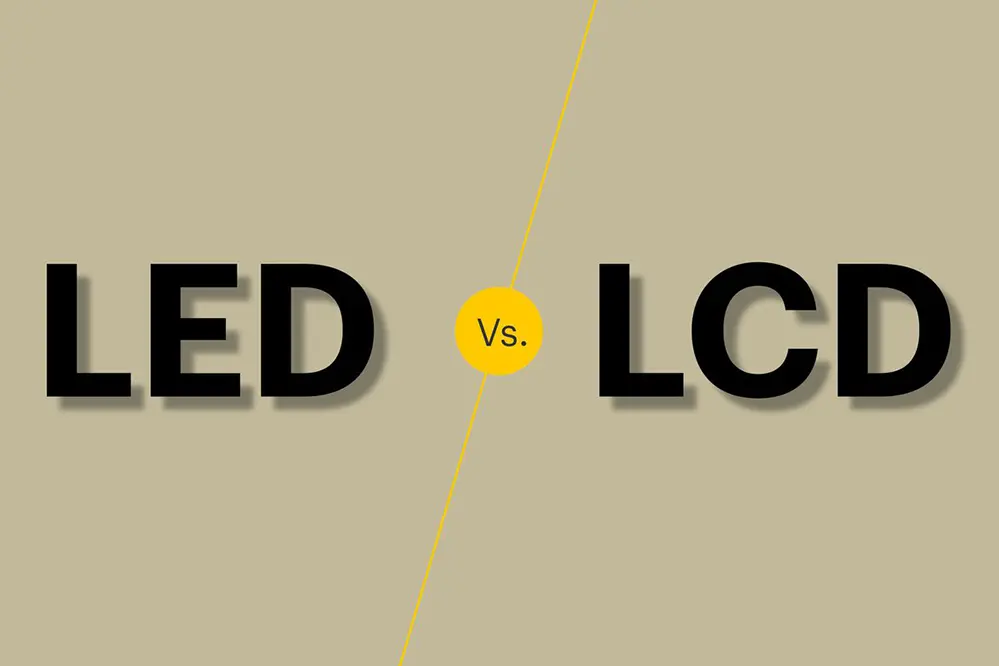Welcome, fellow tech enthusiasts, to an illuminating journey into the world of LED vs. LCD technology! In this blog post, we will embark on a comprehensive exploration of these two cutting-edge display technologies, shedding light on their similarities, differences, and everything in between. So, fasten your seatbelts and get ready to delve into the captivating realm of LED and LCD!
Now, you might be wondering, what exactly sets LED and LCD apart? How do they work, and which one is better suited for your specific needs? Fear not, for we are here to demystify these questions and equip you with the knowledge to make informed decisions. Whether you’re a lighting aficionado or a professional in the field, this blog post will serve as your ultimate guide to understanding the intricacies of LED vs. LCD technology.
But before we dive into the nitty-gritty details, allow me to introduce myself. My name is Tom, and I’ve been deeply immersed in the LED lighting industry since 2005. Over the years, I’ve gained a wealth of experience and expertise, enabling me to provide you with an in-depth analysis of LED and LCD technologies. With a passion for innovation and a keen eye for detail, I’ve meticulously crafted this blog post to ensure it meets your expectations and satisfies your thirst for knowledge.
So, dear readers, let’s embark on this enlightening journey together. From the fundamental principles behind LED and LCD to their applications in various industries, we will leave no stone unturned. Get ready to uncover the secrets of LED vs. LCD technology, as we explore their features, advantages, and limitations. Let’s dive right in and discover the captivating world of LED and LCD displays!
LED Technology
How LED Technology Works
LED, which stands for Light Emitting Diode, is a technology that utilizes semiconductors to emit light when an electric current passes through them. The color and intensity of the light emitted by LEDs can be controlled by adjusting the materials used in the semiconductor. This precise control allows for vibrant and accurate color reproduction.
Advantages of LED Displays
LED displays offer several advantages over other display technologies. Firstly, they are highly energy-efficient, consuming less power compared to traditional LCD displays. This energy efficiency not only reduces electricity costs but also contributes to a greener environment. Additionally, LED displays have a longer lifespan, ensuring that your investment will last for years to come. Furthermore, LED technology provides excellent color accuracy, making it ideal for applications that require vibrant and true-to-life colors.
Applications of LED Displays
LED displays find applications in various industries. In the entertainment realm, LED televisions and computer monitors deliver stunning visuals with their high contrast ratios and color accuracy. LED technology is also widely used in outdoor signage, where the displays need to be bright and visible even in direct sunlight. Moreover, the automotive industry utilizes LED displays for headlights, taillights, and interior lighting due to their energy efficiency and durability. In healthcare, LED technology is employed in surgical lighting and medical equipment displays, providing precise illumination and visual clarity. Advertising and retail sectors also benefit from LED displays, as they attract attention with their vibrant colors and dynamic content.
LCD Technology
How LCD Technology Works
LCD, or Liquid Crystal Display, technology relies on liquid crystals that manipulate light to create images on the display. A backlight is used to illuminate the liquid crystals, and electrical currents control the orientation of the crystals to produce different colors and shades. LCD displays are known for their thin form factor, making them suitable for devices where space is a constraint.
Advantages of LCD Displays
One of the key advantages of LCD displays is their thin and lightweight design. This makes them ideal for portable devices such as smartphones, tablets, and laptops, where slimness and portability are essential. LCD displays also offer power efficiency, allowing devices to operate for longer periods on a single charge. Additionally, LCD technology has improved over the years, providing better color reproduction and viewing angles compared to earlier iterations.
Applications of LCD Displays
LCD displays have found widespread use in various electronic devices. Smartphones and tablets rely on LCD technology to deliver sharp and vibrant visuals, enhancing the user experience. Laptops utilize LCD displays for their thinness and power efficiency, enabling users to work on the go without compromising on performance. LCD screens are also commonly used in automotive infotainment systems, gaming consoles, and medical devices, where a combination of visual quality and functionality is required.
Comparing LED and LCD Displays
Contrast Ratios, Black Levels, and Image Quality
When it comes to contrast ratios and black levels, LED displays have the upper hand. Since LED displays produce their own light, they can achieve deeper blacks and higher contrast ratios compared to LCD displays that rely on a backlight. This results in more vibrant and visually striking images on LED screens.
Energy Efficiency and Environmental Impact
LED displays are renowned for their energy efficiency. They consume less power compared to LCD displays, leading to reduced electricity bills and a smaller carbon footprint. LED technology aligns with the growing demand for eco-friendly solutions, making it an attractive choice for environmentally conscious consumers.
Viewing Angles, Resolutions, and Content Suitability
LCD displays generally offer wider viewing angles, ensuring that the content remains visible even when viewed from the side. However, LED displays have made significant advancements in this area as well, providing improved viewing angles compared to earlier iterations. In terms of resolutions, both LED and LCD displays can offer high-definition and even 4K resolutions, providing crisp and detailed visuals. When it comes to content suitability, LED displays excel in applications that require high brightness and dynamic content, while LCD displays are well-suited for detailed graphics and multimedia content.
Applications and Industries
LED Displays

LED displays have a wide range of applications across various industries. In the entertainment industry, LED televisions and monitors are the go-to choice for home theaters and gaming setups, offering immersive visuals. LED technology is also extensively used in outdoor signage, where displays need to withstand harsh weather conditions while delivering vibrant and attention-grabbing content. In the automotive sector, LED displays are utilized in headlights, taillights, and dashboard displays, providing enhanced visibility and safety. Additionally, LED displays find applications in healthcare settings, advertising billboards, retail displays, and even architectural lighting.
LCD Displays

LCD displays are prevalent in numerous electronic devices. Smartphones and tablets rely on LCD technology to provide high-resolution screens with excellent color reproduction. Laptops utilize LCD displays for their power efficiency and slim design, allowing for portable productivity. LCD screens are also commonly found in automotive infotainment systems, gaming consoles, medical devices, and digital cameras, catering to a wide range of applications.
Considerations for Choosing LED or LCD Displays
Factors to Consider
When choosing between LED and LCD displays, several factors should be taken into consideration. Budget plays a crucial role, as LED displays tend to be more expensive upfront compared to LCD displays. However, it’s important to consider the long-term savings that can be achieved through energy efficiency and durability. Intended use is another factor to consider, as different applications may have specific requirements in terms of brightness, color accuracy, and viewing angles. It’s essential to assess these requirements and choose the display technology that best aligns with your needs.
Cost Analysis
While LED displays may have a higher initial cost, they often provide long-term savings due to their energy efficiency and longer lifespan. By consuming less power, LED displays can significantly reduce electricity bills over time. Additionally, their durability ensures that they require less frequent replacement, further contributing to cost savings in the long run.
Addressing Common Misconceptions and Myths
There are several misconceptions surrounding LED and LCD displays that need to be addressed. One common misconception is that LED displays always offer better image quality than LCD displays. While LED displays generally have better contrast ratios and black levels, LCD displays have made significant advancements in image quality, offering vibrant colors and sharp visuals. It’s important to evaluate the specific features and specifications of each display rather than relying solely on the technology type.
FAQs
What’s better LCD or LED?
LCD and LED are both widely used technologies in the display industry, each with its own strengths and weaknesses.
LCD, or Liquid Crystal Display, is a display technology that uses liquid crystals to create images on a flat panel. It is known for its good color accuracy, wide viewing angles, and ability to display high resolutions. LCD screens are commonly found in televisions, computer monitors, and smartphones. However, LCDs require a separate light source, such as a backlight, to illuminate the screen, which can result in lower contrast levels and difficulty in displaying deep blacks.
On the other hand, LED, or Light Emitting Diode, refers to the type of backlight used in LCD displays. LED backlighting offers several advantages over traditional CCFL (Cold Cathode Fluorescent Lamp) backlighting. LED-backlit LCDs are more energy-efficient, have better brightness, and can provide improved contrast ratios. LED displays also have the ability to dim or turn off specific parts of the backlight, enabling better control over black levels and enhancing contrast.
In recent years, LED technology has advanced further with the introduction of OLED (Organic Light Emitting Diode) displays. OLEDs have individual organic pixels that emit light when an electric current is applied, eliminating the need for a separate backlight. This allows for even greater contrast, thinner displays, and enhanced color reproduction. OLED displays are commonly used in high-end smartphones and TVs.
In summary, while LCDs are known for their color accuracy and wide viewing angles, LED-backlit LCDs offer improved energy efficiency and contrast ratios. OLED displays take it a step further with their self-emitting pixels and superior image quality. The choice between LCD and LED ultimately depends on the specific requirements and preferences of the user, as well as the intended application of the display.
Which is better for your eyes LED or LCD?
LED displays are generally considered better for your eyes compared to LCD displays. LEDs provide higher contrast ratios and better color accuracy while emitting less blue light. This can help reduce eye strain and fatigue, making them a preferred choice for those concerned about eye health.
Which lasts longer LCD or LED?
LCD and LED are two different types of display technologies, and the lifespan can vary depending on various factors. It is important to note that LCD stands for Liquid Crystal Display, while LED stands for Light Emitting Diode.
In general, LED displays tend to have a longer lifespan compared to LCD displays. LED technology uses energy-efficient light-emitting diodes to produce the images, which are known for their durability and longevity. LED displays can last for tens of thousands of hours, providing many years of reliable performance.
On the other hand, LCD displays use a backlight to illuminate the liquid crystals and create the images. Over time, the backlight can become dimmer or stop functioning properly, reducing the overall lifespan of the LCD display. However, it is worth mentioning that the quality of the LCD display and the usage conditions can also impact its longevity.
In recent years, LED technology has become more prevalent in the market, and many manufacturers have shifted towards using LED displays instead of LCD. This transition is largely due to the advantages of LED technology, including better energy efficiency, brighter images, and longer lifespan.
In conclusion, LED displays generally last longer than LCD displays. However, it is important to consider other factors such as usage conditions and display quality when assessing the lifespan of a specific display.
What are the disadvantages of LED TV?
One potential disadvantage of LED TVs is their higher initial cost compared to other types of TVs. Additionally, LED TVs may have a narrower viewing angle, meaning that the picture quality could degrade when viewed from the side. LED TVs are also more prone to motion blur, which can affect the overall viewing experience, especially during fast-paced scenes. Another drawback is that LED TVs can produce a cooler color temperature, resulting in a slightly bluish tint to the picture. Lastly, LED TVs may be more susceptible to screen burn-in, where static images can leave permanent marks on the display if left on for an extended period.
Conclusion
In conclusion, LED and LCD technologies have transformed the way we experience visual content in various industries and electronic devices. LED displays excel in energy efficiency, color accuracy, and vibrant visuals, making them ideal for applications that require high brightness and dynamic content. On the other hand, LCD displays offer thin form factors, power efficiency, and improved image quality, catering to devices where slimness and portability are essential. By understanding the differences, advantages, and considerations of LED and LCD displays, you can make an informed decision when choosing the display technology that best suits your needs. So, whether you’re in the market for a new television, smartphone, or computer monitor, consider the unique strengths of LED and LCD displays to enhance your visual experience.





